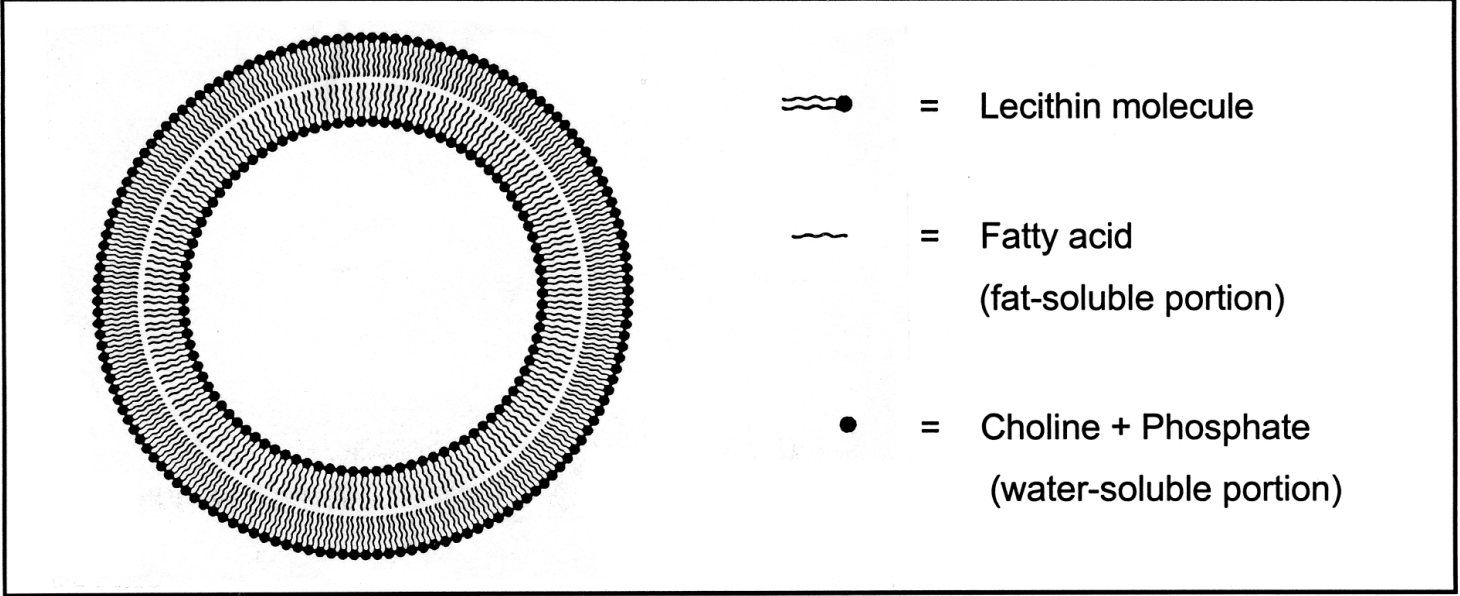5.5: Lecithin
- Page ID
- 63655
Lecithin (a phospholipid—a phosphorus -containing fat) is structurally similar to triglycerides. The difference is that 1 of the 3 fatty acids in a triglyceride is replaced by a water-soluble phosphate-containing compound (Figure 5.2). Fatty acids in lecithin vary, just as they do in triglycerides. Lecithin isn’t needed in the diet; the body can make what it needs.
Because fat, by definition, doesn’t dissolve in water, the fact that a portion of lecithin (the phosphate-containing part) does dissolve in water (water-soluble) gives lecithin a very useful property in both food and the body.
In food, lecithin is useful as an emulsifier (emulsifiers suspend small particles of fat in a watery liquid). It allows fat and water to “mix” by acting as a bridge—the fat-soluble part of lecithin (the fatty acid part) connects with fat, and the water-soluble part connects with water.†
Lecithin in egg yolk is what suspends the oil in mayonnaise, usually made with salad oil, egg yolk, and a bit of lemon juice (or vinegar)—you mix the egg yolk and lemon juice vigorously while adding the oil slowly. The oil is thus finely divided and kept suspended in this emulsion by the lecithin in egg yolk. Hollandaise sauce and béarnaise sauce are made similarly, except with butter instead of oil.
In the body, lecithin makes up the membranes of cells because of the same chemical property that makes it useful as an emulsifier. If you put lecithin in water, the water-soluble part turns toward water, and the fat-soluble part repulses water and is drawn to the fatty acids of other lecithin molecules. This causes the lecithins to automatically arrange into tiny spheres, much like globes filled with water (Figure 5.5).* Body fluids are mainly water, so cell membranes are formed “naturally” from lecithin.

Lecithin forms an ideal cell membrane because it has a center layer of fat (Figure 5.5). Many substances can’t dissolve in fat (i.e., aren’t fat-soluble) and thus can’t easily cross the cell membrane because they can’t get through the fatty acid “barrier.” A cell can thus “choose” what it lets in or out.
Glucose, for example, is dissolved in the water portion of blood and tissue fluid but can’t pass through the fat-layer of cell membranes—glucose doesn’t dissolve in fat. (You can demonstrate in a kitchen that sugar—and salt—dissolves in water but not in salad oil.)
Another reason lecithin forms an ideal cell membrane is that the lecithins aren’t physically connected. The membrane is simply an alignment of separate lecithin molecules (Figure 5.5). This means that a cell can make proteins and insert them into its surrounding cell membrane. Cells do, in fact, do this. Cells make and insert a special protein called a glucose transporter (Figure 6.2) that provides a special pathway for glucose to enter. Other proteins embedded in various cell membranes will be discussed later.
†Monoglycerides and diglycerides (1 or 2 fatty acids attached to glycerol) also act as emulsifiers because they, too, have a fat-soluble (fatty acid) part and a water-soluble part (the part of the glycerol without fatty acids). (Only triglycerides have fatty acids attached at all 3 positions.) Monoglycerides and diglycerides are often used as emulsifiers in food products and are listed as ingredients on the label.
*These can be made in the lab for use in delivering various water-soluble medications (microscopic globes of fat filled with medication) that ordinarily have a hard time getting into cells.


